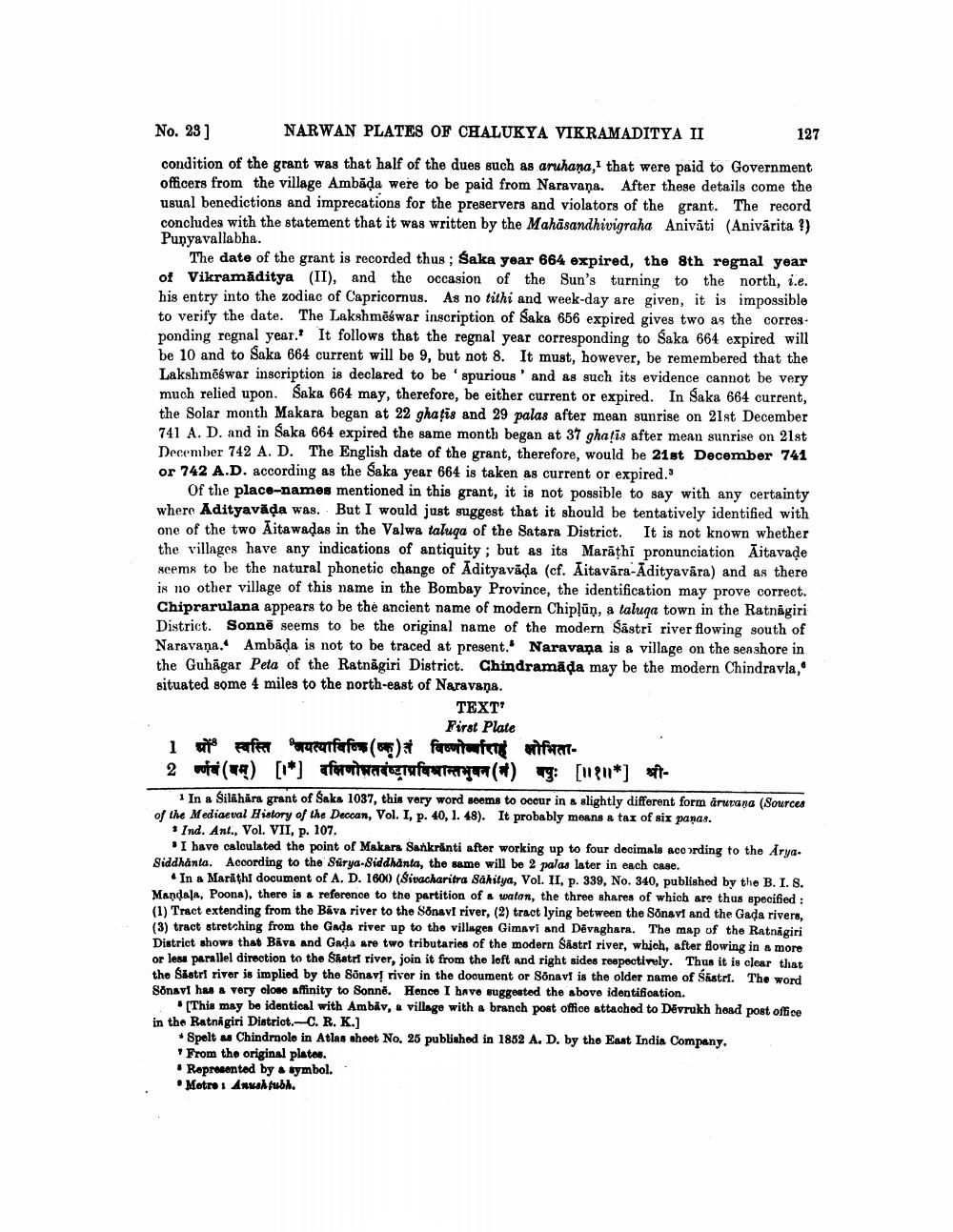________________
No. 23]
NARWAN PLATES OF CHALUKYA VIKRAMADITYA II
condition of the grant was that half of the dues such as aruhana, that were paid to Government officers from the village Ambada were to be paid from Naravana. After these details come the usual benedictions and imprecations for the preservers and violators of the grant. The record concludes with the statement that it was written by the Mahasandhivigraha Anivāti (Anivärita ?) Punyavallabha.
The date of the grant is recorded thus; Saka year 664 expired, the 8th regnal year of Vikramaditya (II), and the occasion of the Sun's turning to the north, i.e. his entry into the zodiac of Capricornus. As no tithi and week-day are given, it is impossible to verify the date. The Lakshmeswar inscription of Saka 656 expired gives two as the corres ponding regnal year. It follows that the regnal year corresponding to Saka 664 expired will be 10 and to Saka 664 current will be 9, but not 8. It must, however, be remembered that the Lakshmeswar inscription is declared to be spurious' and as such its evidence cannot be very much relied upon. Saka 664 may, therefore, be either current or expired. In Saka 664 current, the Solar month Makara began at 22 ghatis and 29 palas after mean sunrise on 21st December 741 A. D. and in Saka 664 expired the same month began at 37 ghatis after mean sunrise on 21st December 742 A. D. The English date of the grant, therefore, would be 21st December 741 or 742 A.D. according as the Saka year 664 is taken as current or expired."
127
Of the place-names mentioned in this grant, it is not possible to say with any certainty where Adityavaḍa was. But I would just suggest that it should be tentatively identified with one of the two Aitawaḍas in the Valwa taluga of the Satara District. It is not known whether the villages have any indications of antiquity; but as its Marathi pronunciation Aitavade seems to be the natural phonetic change of Adityavada (cf. Aitavara-Adityavara) and as there is no other village of this name in the Bombay Province, the identification may prove correct. Chiprarulana appears to be the ancient name of modern Chiplun, a taluga town in the Ratnagiri District. Sonne seems to be the original name of the modern Sastri river flowing south of Naravana. Ambāḍa is not to be traced at present. Naravana is a village on the seashore in the Guhagar Peta of the Ratnagiri District. Chindramaḍa may be the modern Chindravla, situated some 4 miles to the north-east of Naravana.
TEXT'
First Plate
1
rfer "waraffe()
fittery wife.
2 वर्ण (बम् ) [ 1*] दक्षिणोसतवंष्ट्राप्रविभ्रान्तभुवन ( नं) वपुः [ ॥१॥ * ] श्री
1 In a Silahara grant of Saka 1037, this very word seems to occur in a slightly different form aruvana (Sources
of the Mediaeval History of the Deccan, Vol. I, p. 40, 1. 48). It probably means a tax of six panas.
Ind. Ant., Vol. VII, p. 107.
I have calculated the point of Makara Sankranti after working up to four decimals according to the AryaSiddhanta. According to the Sürya-Siddhanta, the same will be 2 palas later in each case.
In a Marathi document of A. D. 1600) (Sivacharitra Sahitya, Vol. II, p. 339, No. 340, published by the B. I. S. Mandala, Poona), there is a reference to the partition of a watan, the three shares of which are thus specified : (1) Tract extending from the Bäva river to the Sonavi river, (2) tract lying between the Sonavi and the Gada rivers, (3) tract stretching from the Gada river up to the villages Gimavi and Devaghara. The map of the Ratnagiri District shows that Bava and Gada are two tributaries of the modern Sästrl river, which, after flowing in a more or less parallel direction to the Sastri river, join it from the left and right sides respectively. Thus it is clear that the Sastri river is implied by the Sonav! river in the document or Sõnavi is the older name of Sastri. The word Sõnavi has a very close affinity to Sonne. Hence I have suggested the above identification.
[This may be identical with Ambäv, a village with a branch post office attached to Devrukh head post office in the Ratnagiri District.-C. R. K.]
+ Spelt as Chindrnole in Atlas sheet No. 25 published in 1852 A. D. by the East India Company.
From the original plates.
Represented by a symbol.
• Metre: Anush tubh.




